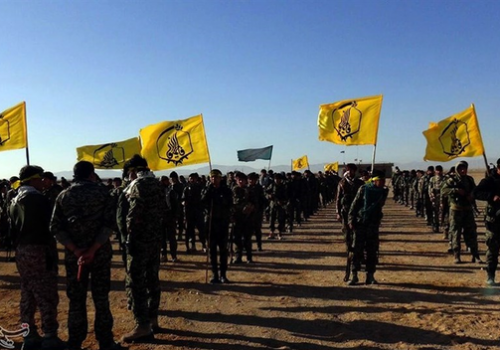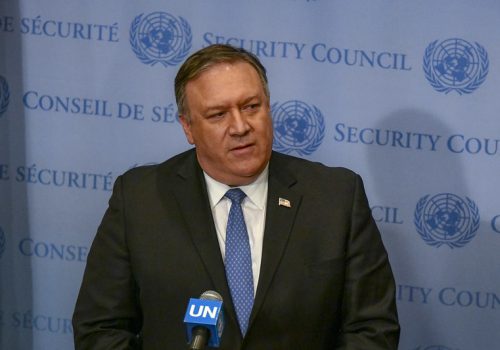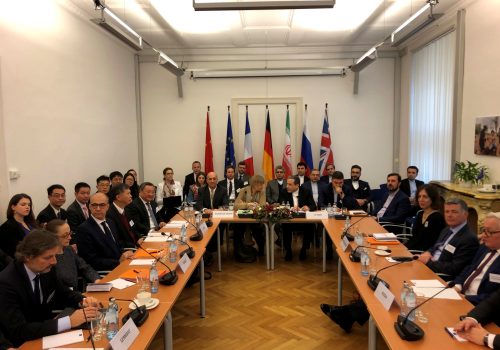Examining Tehran’s regional strategy
Iran’s overarching goal is to fundamentally reorder the prevailing power structure in the region and achieve absolute security in doing so.
To achieve this goal, Iran uses its Islamic Revolutionary Guard Corps – Quds Force (IRGC-QF) to establish and then nurture pro-Iranian armed factions, turning them into political movements that can influence policy outcomes in other countries. This strategy transcends supporting acts of terrorism, although some of Tehran’s allies have repeatedly committed or supported such acts. The IRGC-QF typically tries to “clone” the IRGC and the paramilitary Basij by assembling militias as parallel arms to national forces. The IRGC-QF directs humanitarian aid and social welfare to local communities to build public support for these militias and drive recruitment.
The IRGC and the IRGC-QF have unique capabilities partly because their commanders generally report directly to Supreme Leader Ali Khamenei. Although the Quds Force has only about 20,000 members, it is able to tap other Iranian forces, including the Basij volunteer militia and Iran’s regular military, and deploy them to fronts where Iran can realize tangible gains.
Iran’s policies build on its early attempts to “export” its revolution and are built on the belief that establishing Islamist or otherwise pro-Iranian regimes would deny the US military the ability to operate effectively and would pressure adversaries such as Israel and Saudi Arabia. The region’s conflicts, recent and longstanding, have given Tehran the opportunity to further its goals by intervening in Syria, Iraq, Lebanon, Yemen, Afghanistan, the Gaza Strip, Bahrain, and elsewhere. The gains made in most of these interventions have arguably brought Iran a long way toward achieving its main goals.
Examination of the case studies below suggests that neither US diplomatic engagement nor economic pressure has materially changed Iran’s strategy. Nor has Iran varied this strategy based on prevailing economic conditions in Iran. Rather, Tehran appears to adjust to regional events that present it with opportunities or setbacks. The de-facto alliance between the United States, Israel, and the Gulf Arab states—exemplified by the September normalization agreements between Israel and the United Arab Emirates and Bahrain—represent a reaction to Tehran’s regional gains and are unlikely to cause Iran to alter its strategy significantly.
- Lebanese Hezbollah, long designated by the United States as a foreign terrorist organization (FTO), stands as the main example of the IRGC’s efforts to replicate itself and its Basij in a foreign intervention. After the 1982 Israeli invasion of Lebanon, IRGC forces deployed to the Levant to organize Hezbollah’s militia and terrorist wing. With that support, Hezbollah’s armed wing fought against Israeli forces, gained strength rivaling that of the Lebanese Armed Forces, and has become a significant strategic threat to Israel. Hezbollah’s political arm won seats in the Lebanese parliament, entered the government, and rose in influence to the point where it largely determined the makeup of the government formed in early 2020. As Hezbollah’s influence has grown, Lebanon is increasingly distant politically from Western powers and from Sunni Arab states such as Saudi Arabia.
- In Iraq, the fledgling Islamic Republic began supporting anti-Saddam Hussein Iraqi Shias immediately after the 1979 revolution, organizing them into militias to fight against Iraq during the 1980-1988 Iran-Iraq war. Saddam’s overthrow by US forces in 2003 enabled Iran to build its protégé militias, such as the Badr Organization, into significant forces and political movements. Badr’s leader, Hadi al-Amri, headed a political society that won the second-highest number of seats in the 2018 Iraqi election. IRGC-QF-backed Kataib Hezbollah (KH), designated as an FTO, conducts attacks on US forces in Iraq to pressure the United States to withdraw from the country. The attacks might have contributed to the September Trump administration announcement of a significant drawdown from Iraq and threats to close the US Embassy in Baghdad if the Iraqi government cannot halt these actions.
- In Syria, Iran has used all aspects of its national power to preserve the rule of its close ally, Bashar al-Assad, against an armed rebellion. Iran has provided funds, credits, oil, weapons, and IRGC-QF advisors to Syria. It has created a Basij “clone”—the National Defense Forces (NDF)—and facilitated the intervention of Lebanese Hezbollah fighters and Shia fighters from Afghanistan and Pakistan to assist the Syrian military. Iran has sought to use its presence in Syria to secure a land corridor to Lebanon and to pressure Israel by constructing bases to produce rockets and missiles for Hezbollah. Like Iran, Syria is designated as a state sponsor of terrorism.
- In Yemen, Iran took advantage of the successes of an indigenous opposition group—the Zaidi Shia “Houthi” rebels—to bleed and embarrass Saudi Arabia and project regional power. The IRGC-QF has given the Houthis sophisticated short-range ballistic missiles, air defenses, and drones, which the group has used to significant effect against Saudi targets as well as against some international shipping in the Bab el Mandeb Strait, a key chokepoint. The Houthis will likely play a significant role in any government formed as a result of United Nations-brokered negotiations to end the conflict. The Houthis have so far not been designated as an FTO.
- In Afghanistan, Iran has supported Taliban militant factions, despite past tensions with the group, to focus on its core goal: pressuring the US military. Although Tehran’s efforts were likely marginal in affecting the Trump administration’s decision to negotiate with the Taliban to extricate US forces from Afghanistan, a US departure would remove a key threat from Iran’s eastern border and enable Iran to increase its influence in the country. The Taliban is not marked as an FTO.
- Iran has also sought opportunity In Bahrain, which was shaken by a 2011 uprising by the majority Shia population. Iranian leaders assessed that the establishment of a Shia-led, pro-Iranian government in Bahrain would strategically wound Saudi Arabia and potentially cause the United States to close the regional US naval headquarters that Bahrain has hosted for seventy years. Iran has supported violent underground groups—most notably the Al Ashtar Brigades—which was designated by the Trump administration as an FTO. Iran-backed groups have not succeeded in destabilizing the Sunni Muslim Al Khalifa family, suggesting that Iran’s strategy has not been significantly advanced in Bahrain.
- As part of its efforts to pressure Israel and deny its legitimacy, Iran has supported hardline Islamist Palestinians organizations, particularly Hamas and Palestinian Islamic Jihad (PIJ). Both are Sunni Muslim organizations and both are designated as FTOs. The latter is a relatively small, underground group. Iran supported Hamas’ attempts in the 1990s to disrupt the Israeli-Palestinian peace process through terrorist attacks on Israeli civilian targets and Iran viewed Hamas’ seizure of effective control over the Gaza Strip in 2007 as a significant success. Hamas, PIJ, and other militant groups have used Iran-supplied and indigenously produced rockets during several conflicts with Israel. Iran-Hamas relations have sometimes fluctuated, but Hamas’ political strength has served Iran’s interests by contributing to the stagnation of Israeli-Palestinian negotiations.
Neither the Obama administration’s successful negotiation of the 2015 multilateral Iran nuclear agreement nor the Trump administration’s unilateral withdrawal from the Joint Comprehensive Plan of Action (JCPOA) and re-imposition of sanctions appear to have dented or retarded Iran’s advancement of its regional goals. Because expanding its regional influence is core to Iran’s national security, it is not clear that any combination of US initiatives will persuade or compel the Iranian regime, as currently constituted, to give up its strategy of the past four decades.
Dr. Kenneth Katzman is an Iran expert at the Congressional Research Service. This article is written in a personal capacity and does not reflect the views of the Congressional Research Service or the Library of Congress.
Subscribe for more from IranSource
Sign up for the IranSource newsletter, which provides a holistic look at Iran’s internal dynamics, global and regional policies, and posture through unique analysis of current events and long-term, strategic issues related to Iran.
Image: Syria's President Bashar al-Assad shakes hands with Iranian Supreme Leader Ayatollah Ali Khamenei in Tehran, Iran in this handout released by SANA on February 25, 2019. SANA/Handout via REUTERS


